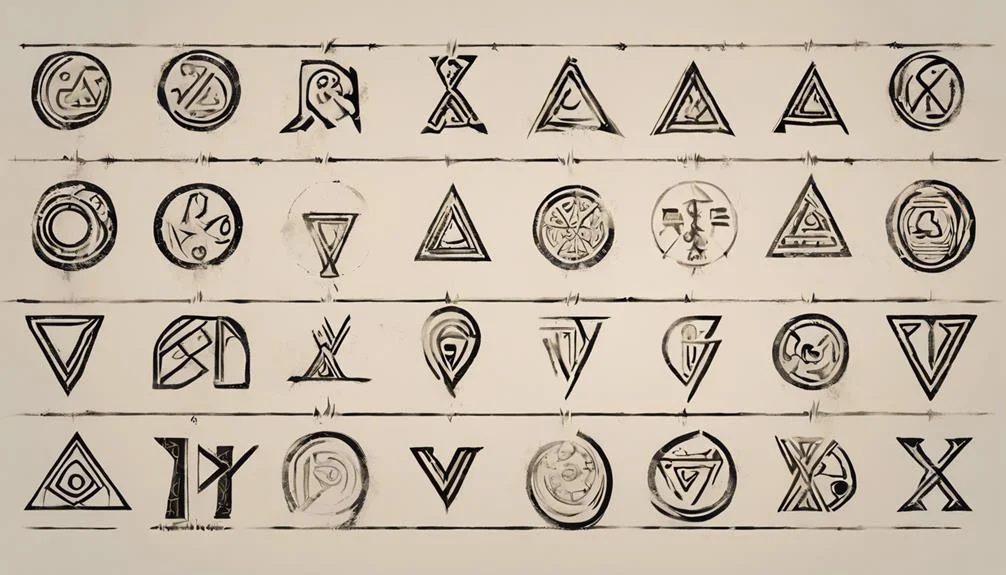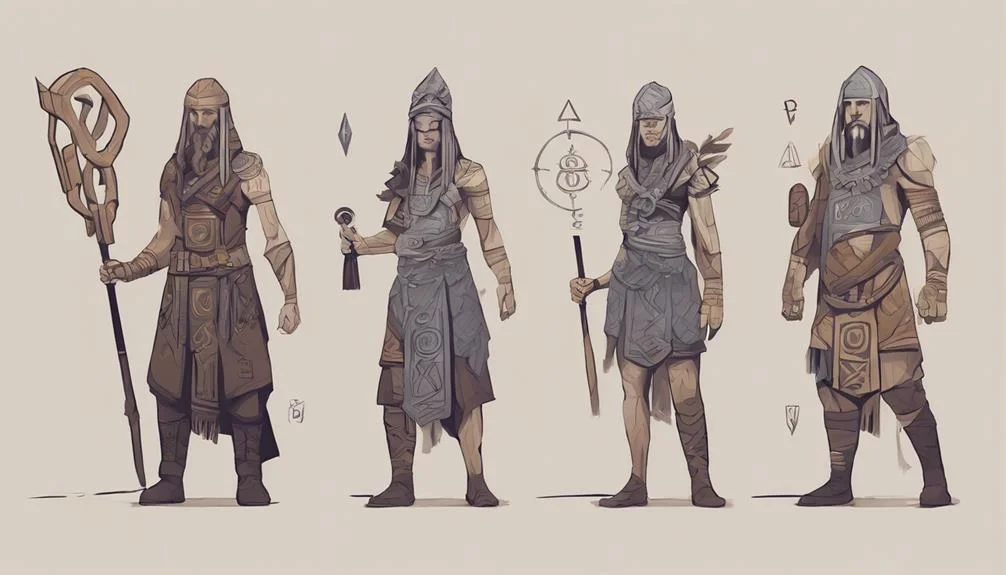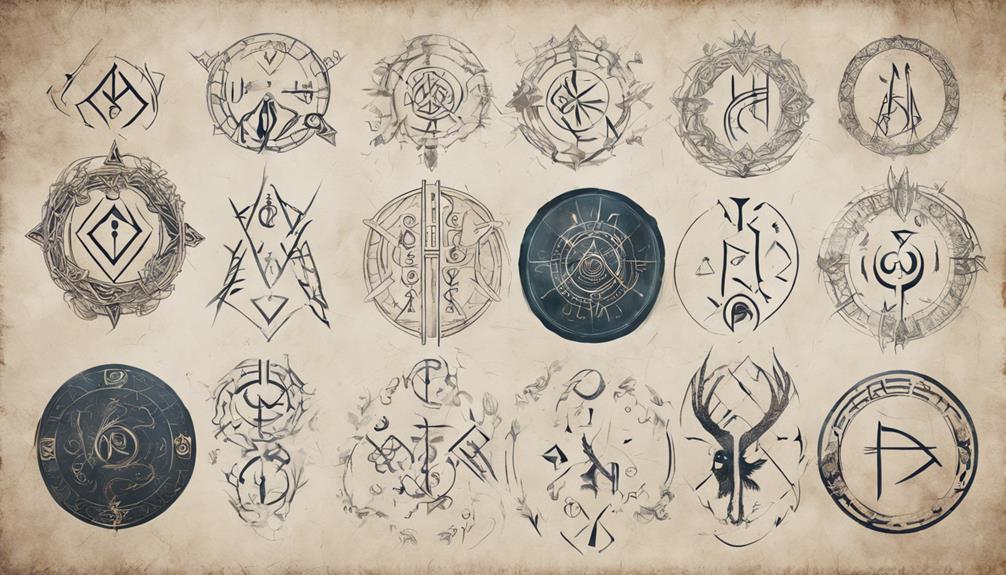Summary
- 1 Origins of the Runic Alphabet
- 2 Symbolism of the Runes of Ancient Futhark
- 3 Interpretation of the Principal Runic Characters
- 4 Practical uses of the runic alphabet
- 5 Runic divination and magic
- 6 Cultural significance of runic inscriptions
- 7 Modern revival of runic studies
- 8 Frequently asked questions
- 8.1 Is it possible to change the order of the Runes for different purposes?
- 8.2 Are there modern variations of the traditional runic alphabet?
- 8.3 How do the meanings of runes differ in different cultures?
- 8.4 Can Runes be used for decorative purposes only?
- 8.5 Are there specific rules for creating runic inscriptions?
Immerse yourself in the world of the runic alphabet, where each symbol has deep meaning, revealing stories of ancient legends and magic. The Elder Futhark characters, divided into three groups, go beyond sounds, offering deep symbolic interpretations. Explore 'Fehu' to understand wealth or 'Ansuz' to hear the whispers of divine wisdom. The Germanic tribes, particularly the Vikings, employed runes to write, practice magic and predict the future. Discover the stories engraved in runic inscriptions, painting pictures of cultural beliefs and historical events. Rune inscriptions could reveal a whole new world of fascination and discovery.
Origins of the Runic Alphabet

Delving into the origins of theRunic Alphabet, you will discover that the roots of this mysterious writing system go back to ancient times. The Runic Alphabet, also known as the Futhark, originated around the 2nd century AD among the tribes. Germanic Northern Europe. The word 'Futhark' comes from the first six letters of this runic alphabet, similar to our 'alphabet' which comes from the first two letters of the Greek alphabet, alpha and beta.
The exact origins of the Runic Alphabet remain a matter of debate among scholars, with some suggesting influences from Latin or Etruscan scripts, while others argue for indigenous development. What is clear is that runes were not only used for writing but also had a meaning symbolic and magical In the visionary world of the Germanic peoples.
As you proceed with your investigation, you will discover how the Runic Alphabet has evolved over time, with various regional variants that emerged. Each rune not only represented a sound but also carried deeper meanings and associations that reflected the spiritual beliefs and cultural practices of the ancient runologists.
Symbolism of the Runes of Ancient Futhark
Let us explore the evocative symbolism of the Ancient Futhark Runes. Discover the rich Historical Origins of these ancient symbols and reveal their profound Spiritual Significance. Immerse yourself in the mystical world of runic symbolism to reveal the hidden meanings of each rune.
Historical origins of runes
Delving into the symbolism of the Elder Futhark Runes reveals a rich web of historical origins dating back to ancient times. Elder Futhark, the oldest runic alphabet, consisted of 24 letters divided into three groups of eight called Aettir. Each rune not only represented a phonetic sound but also had a deeper symbolic meaning. The historical roots of these symbols can be traced back to the Germanic peoples of Northern Europe, particularly the Vikings, who used them for writing, magic and divination.
Runic symbols were often engraved on stones, weapons and personal items, serving as a form of protection or guidance. The intricate designs and meanings behind each rune were believed to connect the user to the spiritual plane and natural forces. Runes were used for communication, to mark territory and even as a way to invoke the gods. Understanding the historical origins of these symbols provides insight into the cultural significance and beliefs of the ancient Germanic tribes who used them in various aspects of their lives.
Spiritual Meaning of Runes
Investigating the spiritual significance of the Futhark Elder Alphabet Runes reveals a deep connection between the symbols and mystical beliefs of ancient Germanic peoples. Each rune has a unique spiritual meaning and power, reflecting aspects of life, nature and human experience. To further explore the symbolism of these ancient symbols, consider the following table:
| Rune | Symbolism |
|---|---|
| Fehu | Wealth, abundance |
| Ansuz | Communication, wisdom |
| Algiz | Protection, connection |
| Thurisaz | Portal, strength |
| Raido | Travel, progress |
| Mannaz | Humanity, self-awareness |
Interpretation of the Principal Runic Characters

Let's dive into the symbolic meanings and historical significance of key runic characters. These symbols have deep cultural and spiritual value, each representing a unique aspect of ancient wisdom. By investigating their interpretations, you will gain insight into the rich web of meanings woven into the runic alphabet.
Symbolic meanings
Unraveling the symbolic meanings of some runic representations offers valuable perspectives on the ancient wisdom and beliefs represented by each symbol. The runic alphabet, also known as the Futhark, is rich in symbolism reflecting the worldview of ancient Runic practitioners. For example, the rune Ansuz represents communication, divine inspiration and the power of words. It is associated with the Norse god Odin, considered the god of wisdom and poetry. The rune Fehu symbolizes wealth, prosperity and abundance, reflecting the importance of the material wealth for runic cultures. Ingwaz, another significant rune, indicates inner growth, fertility and new beginnings. Each rune carries its own unique energy and meaning, offering perspectives on the values and beliefs of runic communities. By delving into the symbolic meanings of these key runic characters, it is possible to gain a deeper understanding of the ancient traditions and spiritual practices Of the runic alphabet.
Historical relevance
Examining the historical significance of key runic characters provides a deeper understanding of the cultural significance and beliefs embedded in the runic alphabet. Runes were not just letters but symbols with deep meanings. For example, the rune 'Fehu' represented wealth and livestock, reflecting the importance of livestock in ancient societies. The rune 'Ansuz' symbolized divine power and communication, indicating the connection between the earthly and spiritual worlds.
Each runic character had a specific meaning in addition to its phonetic value, providing insight into the values and beliefs of runic culture. The rune 'Jera' meant harvest and reward for hard work, illustrating the importance of agriculture and diligence. 'Raido' symbolized travel, both physical and spiritual, emphasizing the idea of progress and personal growth.
Practical uses of the runic alphabet
What practical applications can be found for the ancient runic alphabet in modern times? The runic alphabet, with its unique symbols and meanings, can be used in a variety of practical ways today. Here are some ways to incorporate the runic alphabet into your modern life:
- Tattoos: Many people choose to have runic symbols tattooed for their aesthetic appeal and deeper meanings.
- Jewelry: Runic symbols can be incorporated into jewelry designs for personal adornment or as meaningful gifts.
- Home Furnishings: Use runic symbols in furniture items such as paintings or pillows for a touch of mystery.
- Meditation: Incorporate symbols into your meditation practice for concentration or to set intentions.
- Personal Growth: Some people study the runic alphabet for personal growth and self-discovery, using the symbols as tools for reflection.
These practical uses of the runic alphabet can add a unique and meaningful touch to various aspects of your life.
Runic divination and magic

Delve into the fascinating world of Divination and Runic Magic to investigate the mystical practices associated with the ancient runic alphabet. In ancient times, the runic alphabet was not only used for communication but was also believed to possess magical properties for divination and casting spells. People turned to runic symbols and inscriptions to seek guidance, protection and insight into the future.
To understand how divination and runic magic worked, take a look at the table below, which shows some of the runic symbols and their associated meanings in divination and magic:
| Rune | Meaning in Divination and Magic |
|---|---|
| Ansuz | Communication, divine inspiration |
| Berkana | Growth, new beginnings |
| Raido | Travel, relocation |
| Thurisaz | Protection, defense |
| Ingwaz | Fertility, potential |
Each runic symbol was believed to encapsulate specific energies or messages, guiding practitioners in their efforts. The use of runes in divination and magic added an element of mystery and spirituality to the ancient runic alphabet.
Cultural significance of runic inscriptions
Discover the rich cultural significance engraved in ancient runic inscriptions, revealing a fabric of history and meaning etched in stone. Runic inscriptions provide valuable perspectives on the cultures that used them, offering a window into the beliefs and practices of our ancestors. Here are some key points to explore:
- Historical Context: Runic inscriptions often convey historical events, genealogies and personal histories, shedding light on the lives of ancient peoples.
- Ceremonial Purposes: Many runic inscriptions were created for ceremonial or ritualistic reasons, showing the spiritual practices of the time.
- Artistic Expression: The intricate designs of the runic inscriptions demonstrate a high level of artistry and creativity, reflecting the aesthetic tastes of ancient societies.
- Social Structure: Runic inscriptions can provide clues about social hierarchies, relationships and power dynamics within communities.
- Linguistic Evolution: The study of runic inscriptions helps trace the evolution of languages and dialects, contributing to our understanding of linguistic history.
Modern revival of runic studies

Experiencing a modern renaissance, the study of runic inscriptions has fascinated scholars and enthusiasts alike, revealing new understandings about ancient cultures and languages. The revival of interest in runic studies can be attributed to several factors, including. technological advances that allow better preservation and analysis of runic texts. With the help of digital tools and databases, researchers can now decipher and interpret runic inscriptions more accurately than ever before.
In addition, the modern resurgence of Runic studies has given rise to collaborations between experts from different fields such as linguistics, archaeology and history. This interdisciplinary approach led to revolutionary discoveries and perspectives on the significance of runic symbols in different contexts.
In addition, the accessibility of information through online platforms and academic journals has made it easier for enthusiasts to engage in runic studies. This increased awareness and interest has contributed to a more lively and dynamic of individuals passionate about revealing the mysteries of the runic alphabet.
Frequently asked questions
Is it possible to change the order of the Runes for different purposes?
Certainly, you can change the order Of the runes for different purposes. By rearranging them, you can create new sequences which may have unique meanings or effects. Keep in mind the purpose and symbolism of each rune when changing their order. Experimenting with different arrangements can offer new perspectives and understandings about the versatility and adaptability of the runic alphabet to different needs or intentions.
Are there modern variations of the traditional runic alphabet?
Yes, there are modern variations of the traditional runic alphabet. These adaptations often address specific needs or preferences, such as including additional symbols or adapting the original characters for easier use in digital formats. While the fundamental essence of the runic alphabet is preserved, these modern versions offer flexibility and creativity in the application and interpretation of symbols in contemporary contexts.
How do the meanings of runes differ in different cultures?
The meanings of runes can vary among different cultures, adding depth to their interpretations. In Norse culture, runes such as Ansuz symbolize communication, while in Anglo-Saxon traditions they may represent divine protection. Understanding these cultural nuances enriches your connection to runic symbols and their importance in different contexts. Embracing these different meanings can broaden your understanding for the rich history and symbolism encompassed within the runic alphabets.
Can Runes be used for decorative purposes only?
Of course, you can only use runes for decorative purposes. Many people appreciate the aesthetic appeal of therunic alphabet and incorporate it into artwork, jewelry or tattoos without necessarily delving into the deeper meanings associated with each symbol. Whether you are attracted to the significant historical of runes or simply admire their visual appeal, using them to decorate is a common practice that allows you to express your style and interests creatively.
Are there specific rules for creating runic inscriptions?
When creating runic inscriptions, it is important to follow some general rules. Ensure that each rune is clear and distinctive, avoiding overlapping or overlapping. Maintain the correct orientation of the symbols, usually aligned horizontally from left to right. Consistency in the size and spacing of the runes is critical to the readability. Remember to research the intended message accurately, as accuracy in translation is vital. By adhering to these guidelines, your runic inscriptions will be meaningful and visually appealing.
